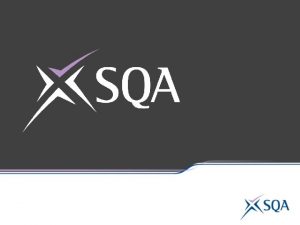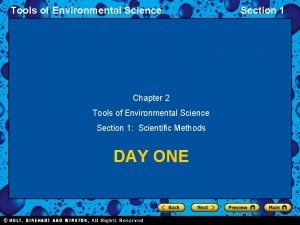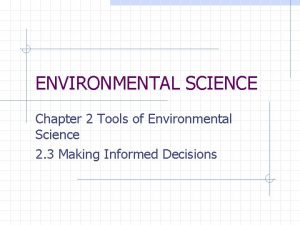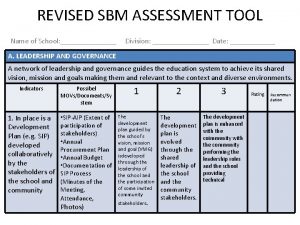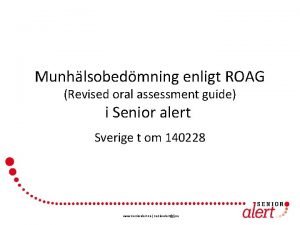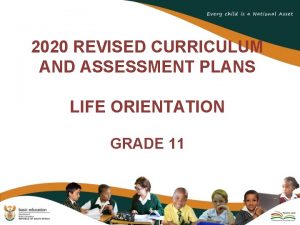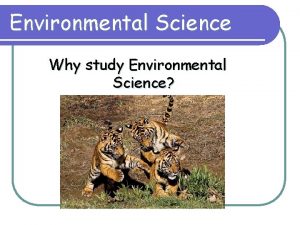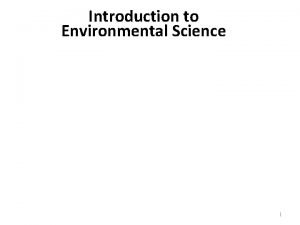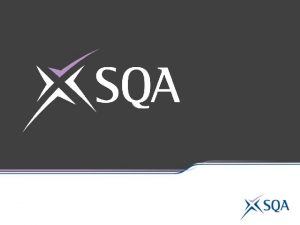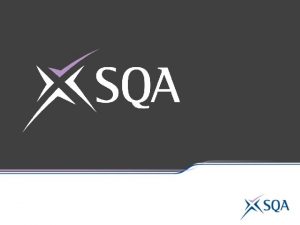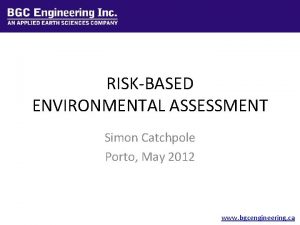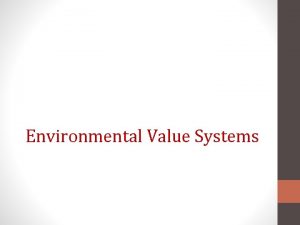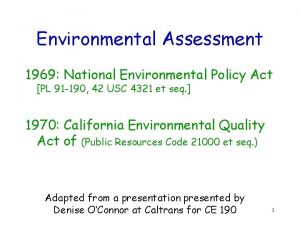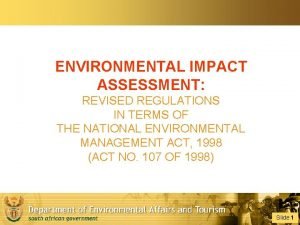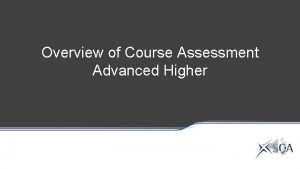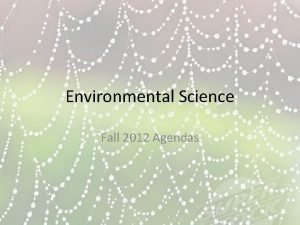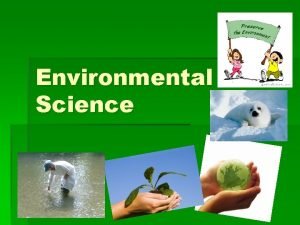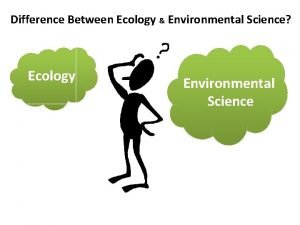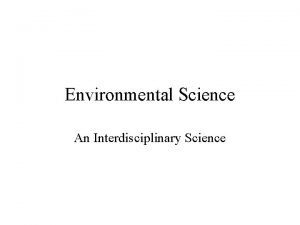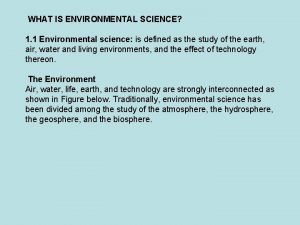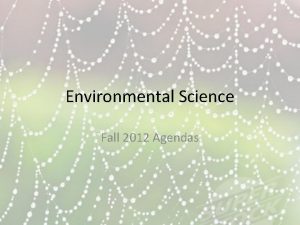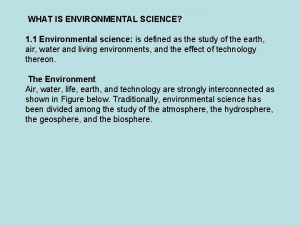Revised National 5 Course Assessment Environmental Science Update

































- Slides: 33


Revised National 5 Course Assessment Environmental Science

Update on session 2016/17 w Increase in entries from 194 in 2016 to 290 in 2017 w Course assessment performed as planned so no adjustments to grade boundaries w Performance improved: 45% A-C rate in 2016 57% A-C rate in 2017 w More detailed feedback in Course Report

Revised National 5 Qualifications w w w Course Specification Course Assignment Task Specimen Question Paper and Marking Instructions Course Support Notes Assignment exemplars and commentaries Course Report 2017

Revised Course Assessment Question paper w 100 marks (previously 80) w 2. 5 hours (previously 2 hrs) w new section Assignment w 20 marks (scaled to 25 to maintain 80/20 weighting) w Mandatory experimental/fieldwork w Conditions of assessment

Course Content Retain unit titles as “organisers” of content. Clarification on depth of coverage required: w quantitative techniques w definitions included w legislation updated w inclusion of experimental/fieldwork techniques and apparatus

Revised National Qualifications Higher ♦ Similar timescale to National 5 ♦ Plan for similar changes to National 5 ♦ Feedback on content

Revised National Qualifications National 3 and 4 units ♦ Unit Specifications and Unit Assessment Support Pack updates ♦ including National 4 Added Value Unit

Assignment

Course Report assignment comments w Standard improving w Candidates increasingly well prepared, with clear understanding of requirements, good layout and organisation of reports BUT w Significant number demonstrating literacy issues w Topics not always appropriate w Data sometimes too complex to process appropriately

Item 2017 performance Available marks Average marks % achievement 1. Aim 1 1. 00 100 2 a. Application of ES (why? ) 1 0. 75 75 2 b. Application of ES (impact) 1 0. 91 91 3. Select 2 relevant sources 2 1. 21 60 4. Select info from sources 2 1. 55 78 5 a. Processing 2 sources (calcs, graphs) 2 0. 98 49 5 b. Present info in 2 different formats 2 1. 36 68 5 c. Labelling of graphs/tables 1 0. 52 52 5 d. Comparison of data from 2 sources 1 0. 46 46 6. Conclusion 1 0. 43 43 7. KU of ES 3 1. 68 56 8 a. Title & headings 1 0. 80 80 8 b. Referencing 1 0. 85 85 8 c. Report structure 1 0. 80 80 20 13. 29 66%

Item mark frequency (%) in 2017 0 1 2 3 1. Aim 0 100 - - 2 a. Application of ES (why? ) 25 75 - - 2 b. Application of ES (impact) 9 91 - - 3. Select 2 relevant sources 27 25 48 - 4. Select info from sources 12 21 67 - 5 a. Processing 2 sources (calcs, graphs) 32 39 29 - 5 b. Present info in 2 different formats 16 31 52 - 5 c. Labelling of graphs/tables 48 52 - - 5 d. Comparison of data from 2 sources 54 46 - - 6. Conclusion 57 43 - - 7. KU of ES 14 29 32 25 8 a. Title & headings 20 80 - - 8 b. Referencing 15 85 - - 8 c. Report structure 20 80 - -

Revised assignment w must involve an experiment or fieldwork raw data w can involve group work (max of 4 per group), with sharing of data within group but not between groups w secondary data from internet, books or journals, for comparison with experimental/fieldwork data w research conducted under some supervision and control w report writing conducted under high degree of supervision and control w 1. 5 hours max for report writing stage, though does not have to be continuous

High degree of supervision and Some supervision and control • Use of resources tightly • Candidates do not need prescribed to be directly supervised • Candidates within direct sight at all times • Display materials covered over • Use of resources, • No access to email, internet, including internet, is not mobile phone tightly prescribed • Candidates work independently • Work submitted is • No interaction with other candidate’s own candidates • No assistance of any description

Teachers should… w Ensure candidate is ready to be assessed w Go over assignment requirements carefully with candidates w Provide guidance about topics, which could include provision of a list of supporting resources (min of 6 sources; candidates to select from list, do not need to use them all) w Provide instructions for experiment/fieldwork w Ensure appropriate risk assessment has been carried out and provide guidance to candidates on safe and correct use of chemicals and equipment w Meet with each candidate to agree topic w Meet with each candidate to ensure aim is achievable, is appropriate, meets H&S considerations, likely availability of supporting resources w Ensure that the report submitted is the candidate’s own work

Teachers must not… w Provide: – a template or model answers – an aim – a set of experimental data – a blank or pre-populated table for results – feedback on results; candidates who identify a problem themselves should be allowed to repeat experiment w Read the reports (at any stage) or provide any form of feedback w Give candidates an opportunity to re-draft their work w Allow the same report to be submitted for more than one subject

Materials which CAN be used at report writing stage w Instructions for Candidates w Candidate’s raw data from experiment or fieldwork w Printouts of internet or literature data, including ref for source of data w Info on underlying environmental science w Experimental method, if appropriate

Materials which must NOT be taken into the report writing stage w Draft of a report w Draft of a description of the underlying environmental science w Specimen calculation or set of calculations for mean or derived values w Pre-prepared graph(s) w Draft comparison of data w Draft conclusion w Draft evaluation of experimental/fieldwork procedure w Assignment Marking Instructions

Revised assignment marking instructions Identification of changes in the new set of Marking Instructions. Applying these to an assignment exemplar.

Question Paper

Key messages A cross-curricular approach incorporating elements of managing environmental resources, biology, chemistry, geography, geology and physics. Different disciplines give Environmental Science its own identity. Requires input from a variety of subject specialists for marking and writing.

Question paper – specific issues Based on 2017 paper: w learn definitions w remind candidates to use units w take time to plot or draw accurately w take time to label axes appropriately when drawing graphs w some calculation questions are worth 2 marks Note - these issues also appear at Higher level, and year on year, so teachers are encouraged to read the Course Report – contains information on challenging areas and advice for future.

Developing the question paper: level of demand difficulty Approx 30% of marks are ‘A’ type and approx. 50% are ‘C’ type. Some questions will therefore be more challenging or complex than others. A question worth, for example, 3 marks, may have 1 mark which is considered to be more challenging/complex to attain than the other 2 marks, ie 1 ‘A’ type mark.

Developing the question paper: mandatory content Minor adjustments to mandatory content: w removal of some content, eg legislation w exemplification, eg definitions w clarification w expansion of sampling methods (to assist with new Section 2) Copy of amended mandatory content in packs.

Developing the question paper: balancing the mandatory content/skills/KU ♦ Living Environment (33 +/- 6 marks) ♦ Earth’s Resources (33 +/- 6 marks) ♦ Sustainability (33 +/- 6 marks)

Command words Calculate Compare Decide Define Describe Determine Estimate Evaluate Explain Give, list, name, state Identify Predict Select Suggest Evidence from question paper that candidates require guidance on the meaning of these command words.

Changes to the structure and length of the paper for 2018

New layout of question paper Removal of units additional 20 marks in question paper w Section 1 – restricted response questions w Section 2 – application of environmental science w Section 3 – extended response questions

Focus on new section 2: Question 14 A decision must be made about whether or not to grant permission for the proposed quarry development. Using the evidence from the sources and your knowledge of environmental science, decide whether or not permission should be granted. Justify your answer. (4 marks)

Focus on new section 2: Question 14 Examples of other potential questions based on the same booklet resource.

Workshop – alternative Section 2 scenario ♦ Sampling (quantitative and/or qualitative methods, why the need for sampling and future monitoring). ♦ Impact of associated human activities on biodiversity (ie building and operating the centre and using the bike tracks). ♦ Economic, environmental and social aspects of the development eg habitat loss, changes in species distribution, change in use of land. ♦ Conflicts between various users of the area eg cyclists vs walkers.

Workshop – alternative Section 2 scenario ♦ Role of statutory agencies in the development of the centre. ♦ Potential for eg soil/path/track erosion if facilities not properly maintained. ♦ Sustainability of materials used in construction (renewable vs non-renewable materials). ♦ Energy usage (wind turbines, solar panels, maybe ground source heat pumps). ♦ Greenhouse gas emissions. ♦ Waste management.

WWW. sqa. org. uk│0303 333 0330
 Immediate update and deferred update in dbms
Immediate update and deferred update in dbms National 5 environmental science
National 5 environmental science Chapter 2 assessment environmental science answers
Chapter 2 assessment environmental science answers Chapter 2 environmental science
Chapter 2 environmental science Tragedy of the commons
Tragedy of the commons Taskpat
Taskpat Localized sbm assessment tool
Localized sbm assessment tool 2020 revised curriculum and assessment plans
2020 revised curriculum and assessment plans 2020 revised curriculum and assessment plans
2020 revised curriculum and assessment plans Revised curriculum and assessment plans 2021
Revised curriculum and assessment plans 2021 Revised programme of assessment 2020
Revised programme of assessment 2020 Revised curriculum 2020
Revised curriculum 2020 Senior alert blankett
Senior alert blankett Grade 7 geography term 1
Grade 7 geography term 1 2020 revised curriculum and assessment plans
2020 revised curriculum and assessment plans 2020 revised curriculum and assessment plans
2020 revised curriculum and assessment plans 2020 revised curriculum and assessment plans
2020 revised curriculum and assessment plans 2020 revised curriculum and assessment plans
2020 revised curriculum and assessment plans 2020 revised curriculum and assessment plans
2020 revised curriculum and assessment plans Revised curriculum 2020
Revised curriculum 2020 2020 revised curriculum and assessment plans
2020 revised curriculum and assessment plans Revised curriculum and assessment plans 2021
Revised curriculum and assessment plans 2021 2020 revised curriculum and assessment plans
2020 revised curriculum and assessment plans 2020 revised curriculum and assessment plans
2020 revised curriculum and assessment plans 2020 revised curriculum and assessment plans grade 7
2020 revised curriculum and assessment plans grade 7 2020 revised curriculum and assessment plans grade 6
2020 revised curriculum and assessment plans grade 6 2020 revised curriculum and assessment plans grade 7
2020 revised curriculum and assessment plans grade 7 2020 revised curriculum and assessment plans grade 6
2020 revised curriculum and assessment plans grade 6 2020 revised curriculum and assessment plans grade 6
2020 revised curriculum and assessment plans grade 6 2020 revised curriculum and assessment plans grade 6
2020 revised curriculum and assessment plans grade 6 Grade 8 ems term 1 data response
Grade 8 ems term 1 data response Electrical technology grade 12
Electrical technology grade 12 2020 revised curriculum and assessment plans
2020 revised curriculum and assessment plans Revised annual teaching plans 2020
Revised annual teaching plans 2020

